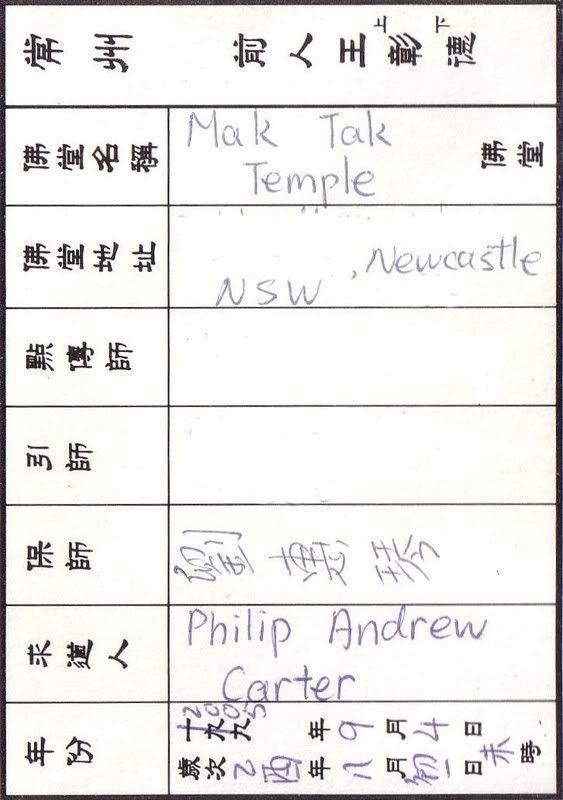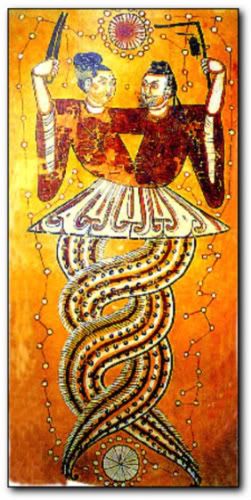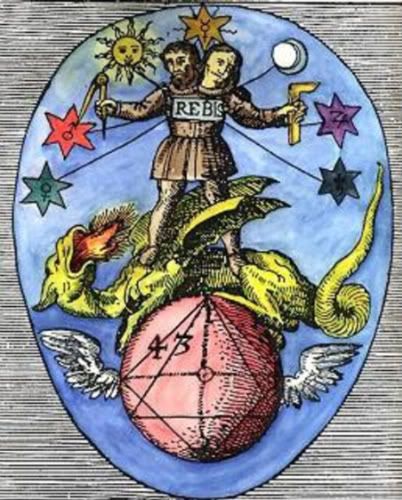|
|
Post by Tamrin on Aug 12, 2008 13:15:31 GMT 10
Chinese "Freemasons" Hung Society or the Society of Heaven and Earth, by J.S.M. Ward & W.G. Stirling. See also Wikipedia's Tiandihui entry and this article from the Australian Centre for Fraternal Studies. My experience with one of these groups has been peculiar in so far as it is both mixed and separate. Men and women are present, (of the members observing, the women are in the "North" and the men in the "South"), but most of the ceremonies are repeated (by the same Officers) for each sex. This tends to make for long sessions. They are delightful people but, while I cannot be too specific, I can say there is a LOT of kowtowing involved, much too much for my Western frame and, not knowing Cantonese, I miss a lot, although key points are translated for the benefit of the few Westerners present.  My "Chop" with details of sponsors, etc., erased from image for their privacy My "Chop" with details of sponsors, etc., erased from image for their privacy |
|
|
|
Post by devoutfreemason on Aug 13, 2008 0:25:28 GMT 10
I am very excited to learn more. I would love to attend their ritual work. Some day I will see if this is possible.
|
|
|
|
Post by Tamrin on Aug 13, 2008 12:03:38 GMT 10
Bearing in mind that the term "Freemasons" in this case was one "Foreign Devils" applied to these Chinese societies and only subsequently adopted by some them when seeking to describe themselves to Westerners, we should not suppose that they consider themselves our fraternal brothers nor we theirs (except in the sense that both institutions are modelled on the supposition that all wo/men are "brothers"). Even so, some similarities are intriguing. we should also consider: |
|
|
|
Post by Tamrin on Aug 13, 2008 14:52:34 GMT 10
Half seriously, half mischievously and half because I'm not good at fractions, I'm throwing another theory of origins into the mix. Bearing in mind the similarity of many Chinese fraternal customs with ours and widespread correspondences around the globe. Also considering Gavin Menzies description of the huge 1421 Chinese expedition marking both the high point and virtual end of early Chinese global trade and cultural exchange, could China be the point of origin from which these fraternal customs spread, via these early exchanges? Against this theory (albeit, only novel in relation to its connection to the 1421 theory), is what the Grand Lodge of British Columbia and Yukon has to say about Chinese Freemasons (excerpt): Personally, I am not ready to absolutely discount the many points of correspondence. See also (same site): 1850 - 1950: Colonial and Freemason Concerns Dian H. Murray, in collaboration with Qin Biaoqi The Origins of the Tiandihui: The Chinese Triads in Legend and HistoryStanford, CA : Stanford University Press, 1994. pp. 90-92 |
|
|
|
Post by maximus on Aug 14, 2008 13:41:08 GMT 10
I listened to a radio interview with Gavin Menzies on that very book on Coast to Coast AM with George Noory. Interesting piece of the historical puzzle we hear nothing about.
|
|
|
|
Post by Tamrin on Aug 14, 2008 14:18:48 GMT 10
I listened to a radio interview with Gavin Menzies on that very book on Coast to Coast AM with George Noory. Interesting piece of the historical puzzle we hear nothing about. The change of name for the U.S. Market from, 1421: The Year China Discovered the World, to, 1421: The Year China Discovered America, is curious. |
|
|
|
Post by maximus on Aug 15, 2008 13:01:18 GMT 10
The change of name for the U.S. Market from, 1421: The Year China Discovered the World, to, 1421: The Year China Discovered America, is curious. It's a common marketing ploy. The US market is huge, so the publishers often change a book title to appeal (they believe) to the target market. I've noticed the same with other books, Such as Graham Hancock and Robert Buval's The Keeper of Genisis, which was changed here to The Message of the Sphinx. |
|
|
|
Post by Tamrin on Oct 29, 2008 19:59:14 GMT 10
Revolution and respectability:
Chinese Masons in Australian history
by John FitzgeraldThe Chinese now are all Freemasons, and form one brotherhood.
The old Emperor and his son are Chinese Tartars,
and the new emperor intends to carry out all one brotherhood. Howqua, Chinese interpreter, Melbourne 1855 [Introduction - Excerpt - Linked Above] |
|
|
|
Post by Tamrin on Nov 11, 2008 18:16:18 GMT 10
|
|
|
|
Post by Tamrin on Nov 11, 2008 19:04:51 GMT 10
  Compare the previous illustration (left) with this Western version (right) of the Zakar or Rebis (note the reversal of the emblems' gender associations) |
|